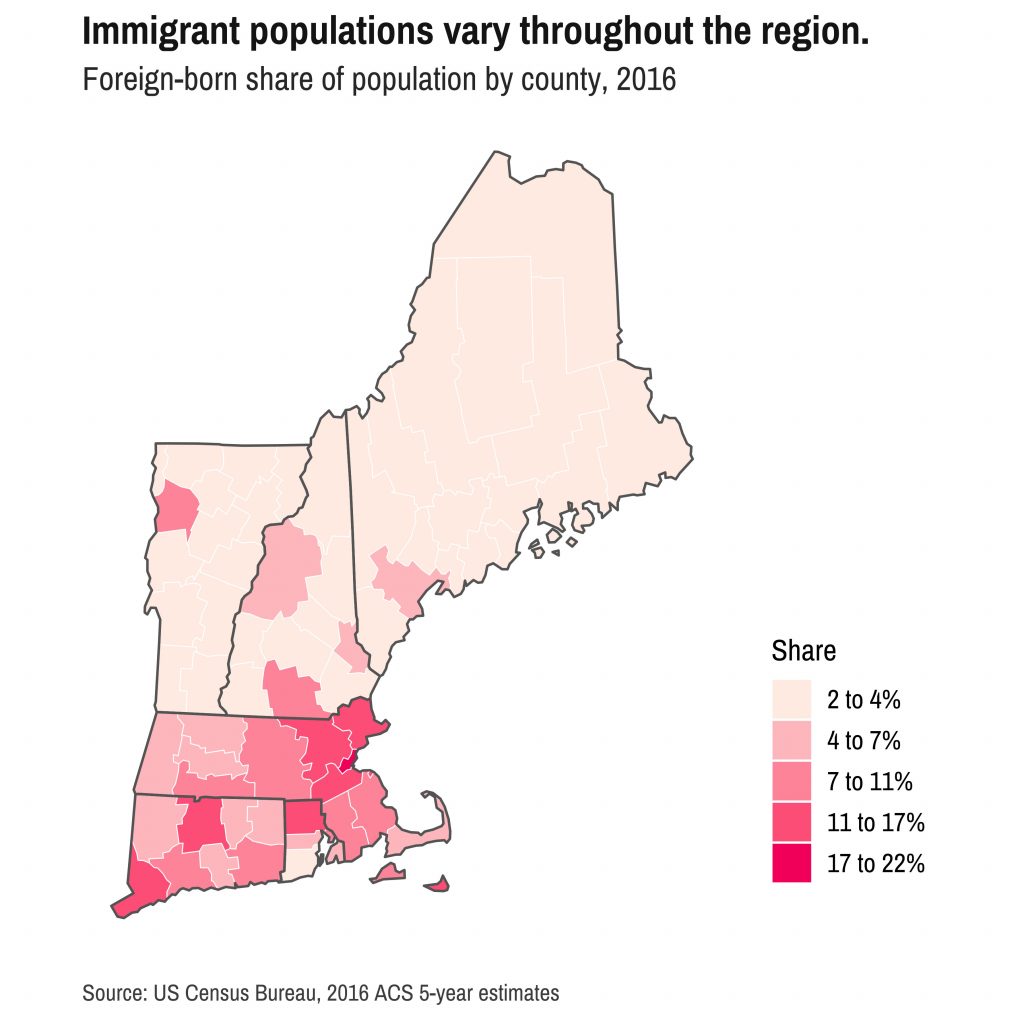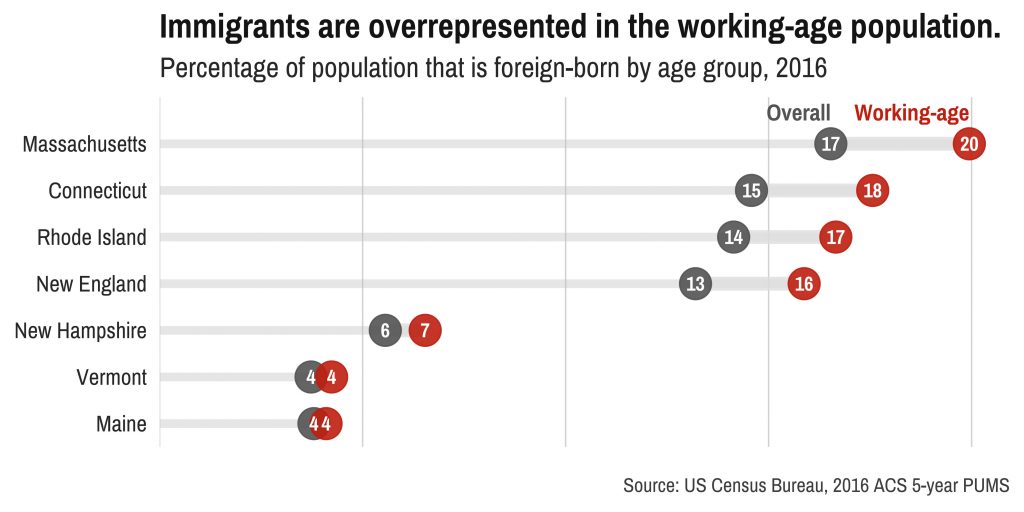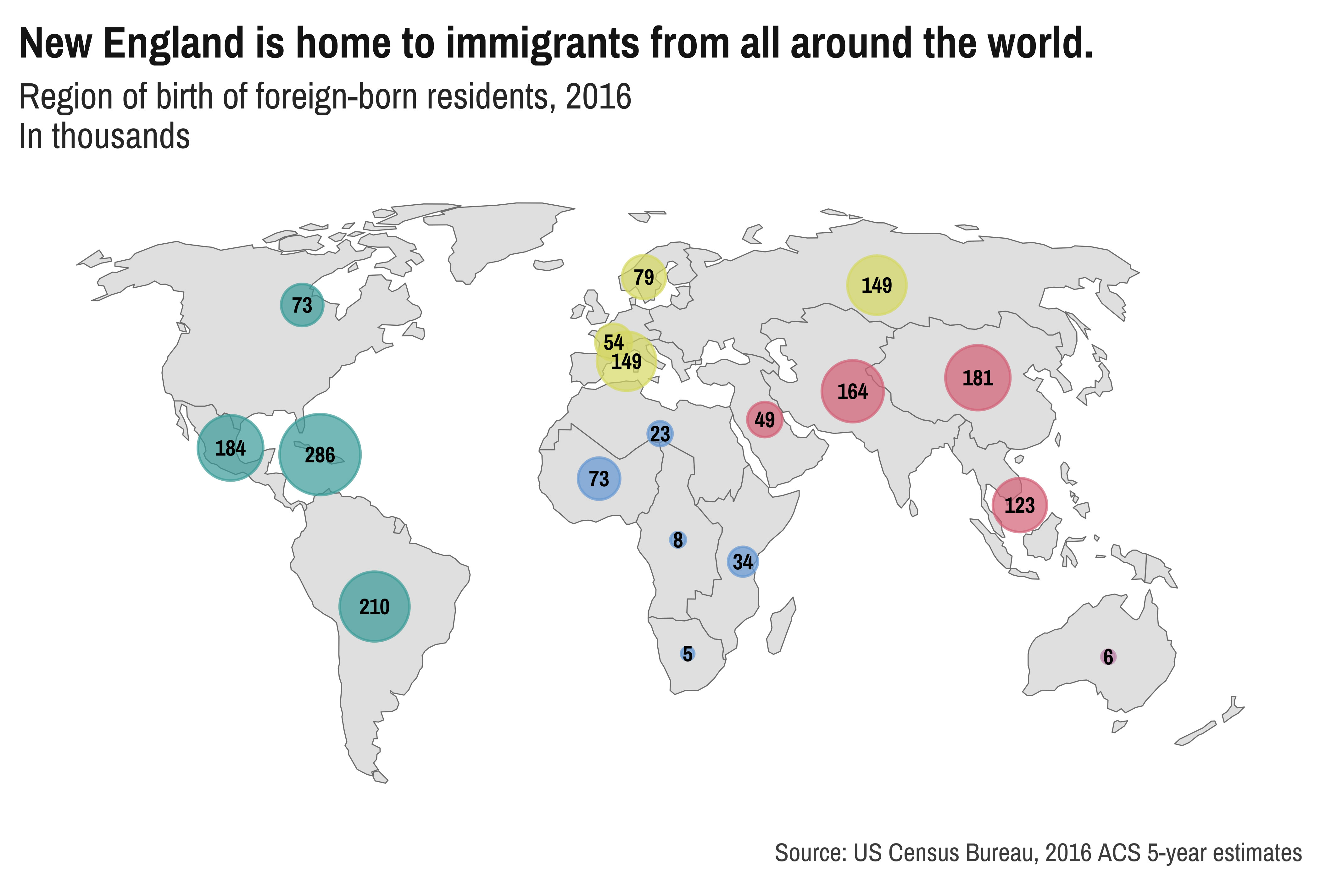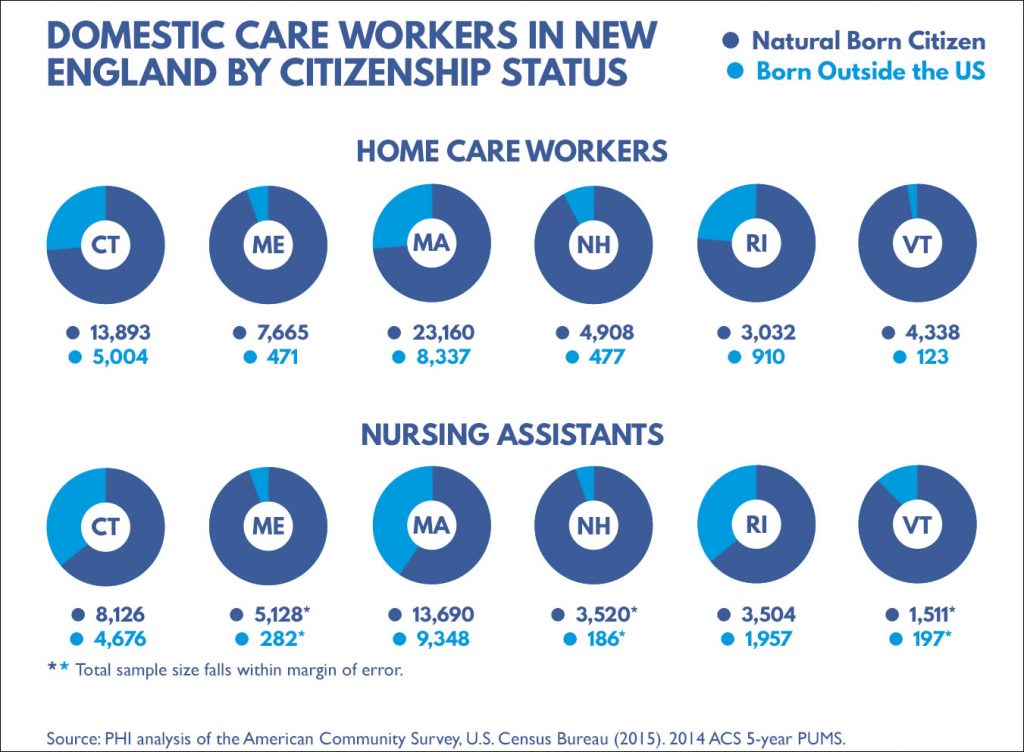Is Immigration Good For The US Economy?
One of the biggest political arguments against immigration is that it hurts the chances of American-born workers to succeed and damages the U.S. economy. But in New England, where the population is rapidly aging and the young replacement workers needed to sustain the workforce are leaving, immigration just might be the answer.
On this special segment of NEXT, we speak with experts about how immigration is affecting the local and national economy through data, statistics, and the human stories behind them. We speak with Ahmed Mushfiq Mobarak, Professor of Economics at Yale University, Shannon Dooling, a reporter for the NENC and WBUR, and Will Kneerim, the Director of Employment and Education Services at IRIS. You can listen to an excerpt of the panel discussion below:
Can Immigration Improve The Economy?
In this video, Professor Mushfiq Mobarak answers questions on how immigration can improve the economy.
PANEL HIGHLIGHTS:
These are excerpts of the panel and do not reflect the participant’s full statements or thoughts. These excerpts have been edited for clarity.
John Dankosky: There is a feeling that if people come from elsewhere, it is going to naturally negatively impact the availability of jobs for native born Americans. Talk a bit about the research you’ve done and seen on that.
Mushfiq Mobarak: It turns out that when you look at the data very very carefully, the story is not that simple. There is a subset of people in the U.S. economy [who are going to be hurt by immigration] and that’s going to be the previous generation of immigrants.
There are the jobs, there are the wages, and there’s the overall impact of the U.S. economy, which is kind of an abstract thing in a lot of ways. I’m wondering if you talk about the economy as a whole, what do you see as the impact of this increasing number of immigrants coming over the course of the last couple of decades?
One of the mistakes we’re making when people think about the adverse effects of immigration, is that if you think there is some fixed number of jobs in the U.S. Economy, and whenever an immigrant comes in they take up some of those jobs, then, of course, you’re going to see negative effects. But that’s a strange and unsophisticated way to think of the world. […] The way to think about how jobs are changing, is that if there are immigrant workers who are lowering the costs of operating the business, that actually creates the opportunity for entrepreneurs to hire Americans to be client-facing.
I want to go into the idea of the rate of immigration and the overall numbers. If it’s true that we don’t have a magic number of jobs in the U.S., we probably need though to arrive at some sort of baseline of what we might set as a target. Is there a way to calculate how much immigration over how many years is going to make the inputs into the economy such that we can be sustained and growing? What is the tipping point at which too much immigration is too much.
The short answer is no. There is no magic formula. Any number we get is probably not going to be credible. […] It depends on elasticities. When an immigrant worker comes in, how much cheaper is the operation of the business, therefore how many workers can disperse and hire relative to how many jobs are being lost because there are some fixed constraints on how many jobs can be created. So that itself is complex. But it gets even more complex beyond that. Because the effect of immigration is not just taking versus creating jobs, it’s also about innovation. It turns out that immigrants are one of the most important contributors to innovation in the United States. And innovation is the sector that we do really well in. […] More than 50% of all Engineering PhDs handed out in the U.S. over the past 20 years have been to foreign-born scientists. Many of them stay back, they start new companies, they patent new technologies. America has been able, through its immigration policies in the past, to attract talented people.
How Does Immigration Affect New England’s Economy?
The data behind immigration trends in New England shows the majority of immigrants in the region are located in the southern states, and that this group comes from all over the world. While in previous decades, most immigrants were from Europe, in recent decades immigration has surged from Asia and Latin America. Immigrants are over-represented in the working age population, and in some of the region’s largest industries. Furthermore, New England’s foreign-born immigrants are more likely to be self-employed than the native-born workforce.
Explore the data in the graphs below:
New England is home to 1,859,602 immigrants, making up 13 percent of the region’s population. Much larger shares of the populations in southern New England states are foreign-born than in the northern states.
Immigrants are concentrated most heavily in counties in Southern New England. Most counties in Maine, New Hampshire, and Vermont are less than 10 percent foreign-born, whereas Fairfield County, Connecticut and Suffolk County, Massachusetts are 17 and 22 percent foreign-born, respectively. In New England, immigration may affect the economy differently, bringing in working-age people in a population that is rapidly aging.
Larger shares of New England’s working-age population are foreign-born than its overall population. More than 1.5 million immigrants in New England are between the ages of 16 and 64, making it 16 percent of this age group.
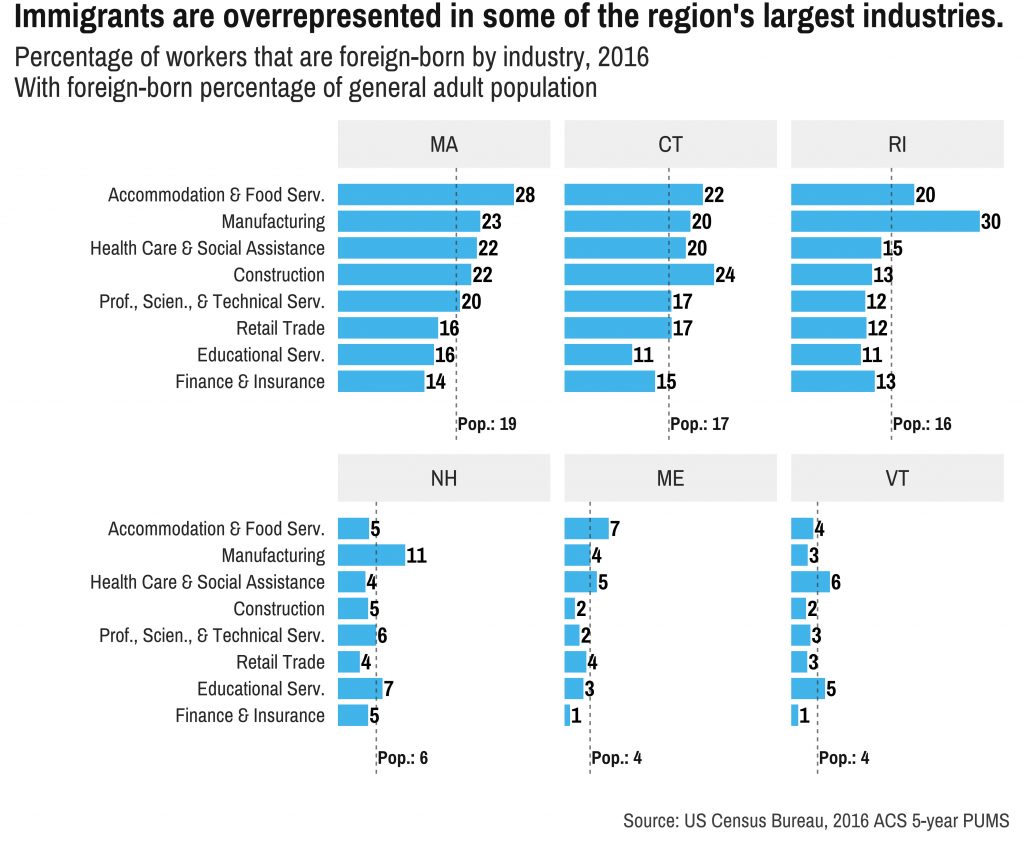
Immigrants are overrepresented in some of the region’s largest industries. Graph courtesy of DataHaven
Immigrants work in all industries throughout New England. In some of the region’s largest industries, such as accommodations and food service, manufacturing, healthcare, and social assistance immigrants make up larger shares of those industries’ employees than their share of the overall working-age population.
Who Is Coming to New England? What Work Is Available To New Immigrants?
New England’s immigrant populations come from every region of the world. In many cases, groups of immigrants from one region have settled into clusters in neighboring New England counties. About two-thirds of New England’s foreign-born population were born in just 19 countries, mostly in Latin America, the Caribbean, and Asia.

Immigration has surged in recent decades, especially from Asia and Latin America. Graph courtesy of DataHaven
Many of New England’s immigrants entered the U.S. relatively recently. Nearly half the region’s foreign-born residents moved to the U.S. between 2000 and 2016, and the majority of these new Americans were born in Asia, Central America (including Mexico), or the Caribbean. In contrast, previous generations of immigrants came largely from Europe. But once immigrants arrive in the region, it is not always easy to find work.
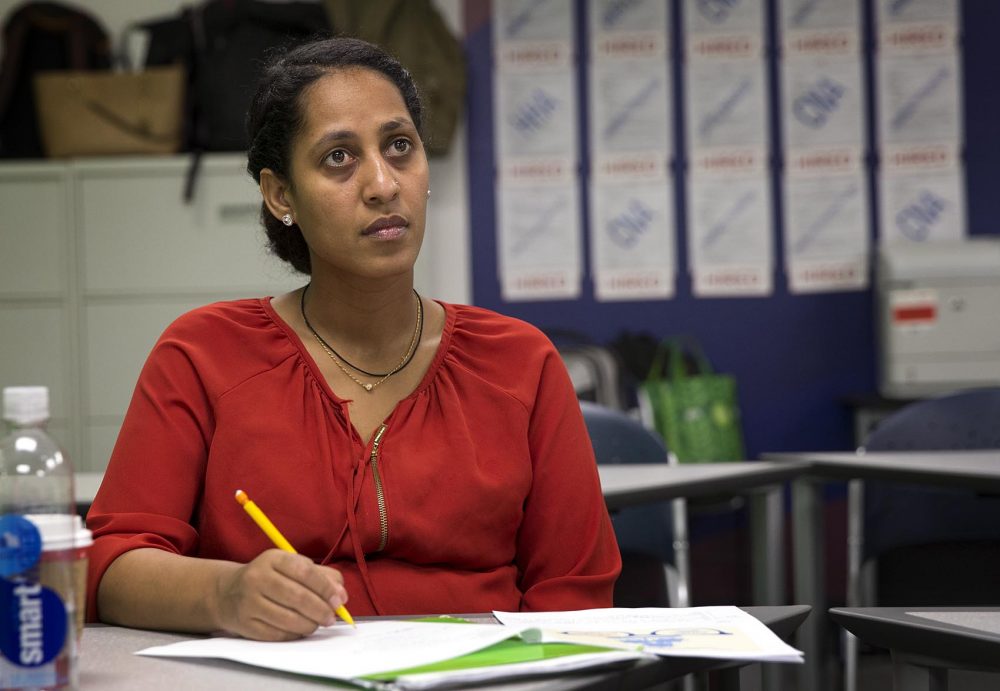
Ayehu Lakew was one of the students in the class “Working with Frail Elders” at Jewish Vocational Services in Boston. She came to Boston on a diversity visa and hopes to become a nurse.
However, there are fields that are increasingly opening to immigrant workers. One example of that is the healthcare industry. Ayehu Lakew came to Boston from Ethiopia on a diversity visa. After working in a parking lot, Lakew enrolled in a course at Jewish Vocational Services in Boston, titled “Working with Frail Elders.” She hopes that she will use this course, and eventually become a nurse. Listen to this clip of Lakew talking about the course and her plans for the future:
In this aging region, immigrants are becoming increasingly necessary in the healthcare sector. Northeastern Professor of Public Policy Barry Bluestone says, “In Massachusetts, we project we’re going to need 93,000 additional home-care workers over the next 10 years, or almost 10,000 a year. These are overwhelmingly immigrant workers and what I fear is if the current political environment either shuts off immigration or look at the United States and say this is not a very comfortable or safe place to be, I don’t have any idea how we’re going to fill those 10,000 jobs each year.”
As of 2014, over a quarter of Massachusetts’ home health care workers were foreign-born. And the healthcare industry’s reliance on immigrant labor is only expected to grow, especially in New England. In addition to working in existing industries, immigrants also tend to be self-employed, and start businesses and encourage innovation.
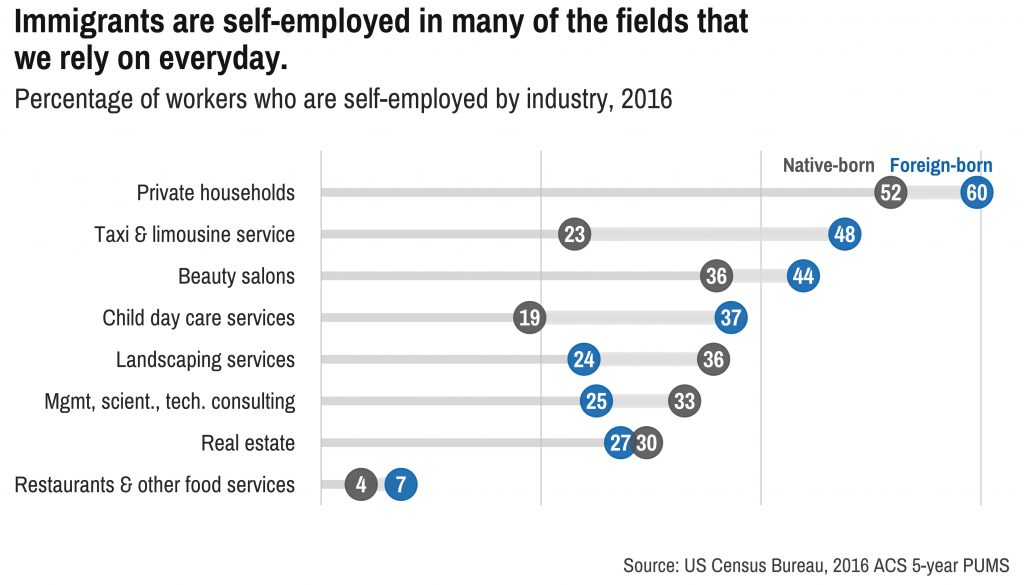
Immigrants are self-employed in many of the fields that we rely on every day. Graph courtesy of DataHaven
New England’s foreign-born residents are slightly more likely to be self-employed than New Englanders born in the U.S.: 121,886 immigrants are self-employed, making up 10 percent of employed adult immigrants. Large shares of working immigrants are self-employed in industries such as real estate and construction, and many own businesses in common service fields, such as child care, salons, and taxi services.
This aspect of immigration, the way that immigrants add to the economy by creating businesses and innovation, is often overlooked. One local example of immigrants re-vitalizing a town is in Lewiston, Maine. From 2001 to 2011, over 7,000 immigrants from Africa, mostly Somalia, arrived in Lewiston, a city that formerly had a population of 36,000 and was 96 percent Caucasian. The city began to experience an economic re-vitalization due to this influx of immigrants. Amy Bass, author of the book One Goal: A Coach, A Team, and the Game that Brought a Divided Town Together describes the change in this audio clip:
But what are the situations when immigrants do not contribute to the economy? What happens when there is uncertainty in their lives? Shannon Dooling explored one story of a family that is mixed-status: only some of them are citizens, others are temporary residents.

Isidro Macario, 27 right, was brought here as a young child from Guatemala is facing deportation potentially making him leave behind the rest of his family, (l-r) Saul, 16, Anthony, 18 and Erwin, 21, who were born in the United States. (Jesse Costa/WBUR)
There are four brothers in the Macario family: Saul, Erwin, Anthony, and Isidro. While Saul, Erwin, and Anthony are U.S. Citizens, Isidro is not, and was deported to Guatemala in February. After Isidro was deported, two of the brothers failed out of High School, and are seeing their economic prospects for the future dwindle. Isidro explains the challenges facing his family:
And the youngest brother in the family, Saul, 16 when Shannon spoke with him, felt like his family was being taken away from him:
These are just some of the issues facing the aging New England economy, and the immigrants who are living here. To learn more about the economic effects of immigration on the region, listen to the excerpt of our panel discussion at the top of the page.
Thank you to the International Festival of Arts and Ideas, to DataHaven, and to our panelists. This program was moderated by John Dankosky and produced by Lily Tyson.



